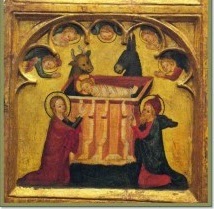Fear not: for,
behold, I bring you good tidings of great joy, which shall be to all people.
For unto you is
born this day in the city of David a Saviour, which is Christ the Lord.
And this shall be
a sign unto you;
Ye shall find the
babe wrapped in swaddling clothes, lying in a manger.
“The power of the ministry of God translateth out of darkness into glory, it raiseth men from earth and bringeth God himself down from heaven, by blessing visible elements it maketh them invisible grace, it giveth daily the Holy Ghost, it hath to dispose of that flesh which was given for the life of the world and that blood which was poured out to redeem souls." (Richard Hooker, Of the Laws of Ecclesiastical Polity)
"The Eucharist is the sacrament of Love: it signifies Love, it produces love. The Eucharist is the consummation of the whole spiritual life." (St. Thomas Aquinas, Summa Theologica)
Again and again throughout his earthly ministry, Our Lord emphasized the importance of the believer's union with him - a union accomplished through baptism and partaking of his body and blood. This was a stumbling block to many of his hearers, despite the rich Eucharistic imagery of the Old Covenant.
"The Eucharist is the sacrament of Love: it signifies Love, it produces love. The Eucharist is the consummation of the whole spiritual life." (St. Thomas Aquinas, Summa Theologica)
Again and again throughout his earthly ministry, Our Lord emphasized the importance of the believer's union with him - a union accomplished through baptism and partaking of his body and blood. This was a stumbling block to many of his hearers, despite the rich Eucharistic imagery of the Old Covenant.
While preaching, Our Lord compares himself to the manna that sustained the Hebrews during their desert sojourns. With the comparison, he includes a promise:
Verily, verily, I say unto you, Except ye eat the flesh of the Son of man, and drink his blood, ye have no life in you. Whoso eateth my flesh, and drinketh my blood, hath eternal life; and I will raise him up at the last day. For my flesh is meat indeed, and my blood is drink indeed. He that eateth my flesh, and drinketh my blood, dwelleth in me, and I in him. As the living Father hath sent me, and I live by the Father: so he that eateth me, even he shall live by me. This is that bread which came down from heaven: not as your fathers did eat manna, and are dead: he that eateth of this bread shall live for ever.
Through this message, Our Lord demonstrates the incarnational manner of salvation. Christ was made man not merely to provide forgiveness of sins, but to restore man's nature and all of creation. Through this restoration, man becomes united with God through union with the incarnate Christ. This results in the glorification foretold in Our Lord's transfiguration.
But the good news of the Incarnation is inseparable from the means by which we are united with it - altar and sacrament. This truth is presented immediately upon Our Lord's birth.
The Blessed Virgin Mary and her husband Joseph, having received the message of the gospel from the archangel Gabriel, set the infant Christ in a feeding trough. Later that night, angels proclaim the sign of the infant in a feeding trough to local shepherds. They will find the Saviour in the City of David, Bethlehem, "the house of bread." The first presentation of Our Lord is as a Eucharistic symbol. The manger is the altar and the cross, the Child, the Bread of Life.
The Blessed Virgin Mary and her husband Joseph, having received the message of the gospel from the archangel Gabriel, set the infant Christ in a feeding trough. Later that night, angels proclaim the sign of the infant in a feeding trough to local shepherds. They will find the Saviour in the City of David, Bethlehem, "the house of bread." The first presentation of Our Lord is as a Eucharistic symbol. The manger is the altar and the cross, the Child, the Bread of Life.



No comments:
Post a Comment